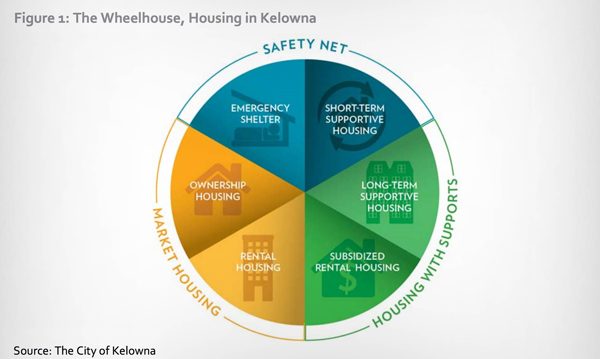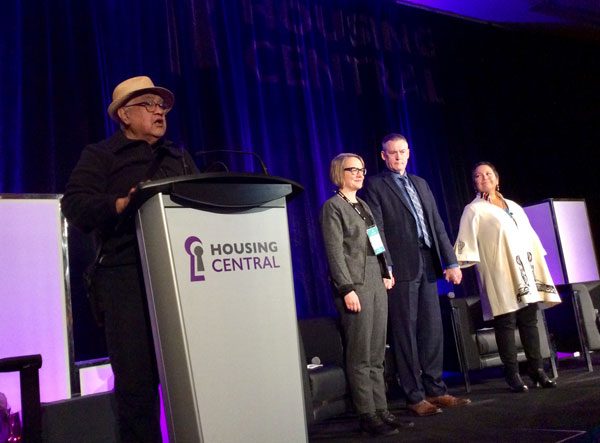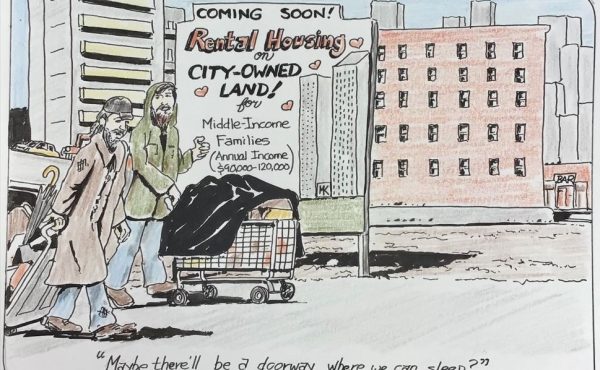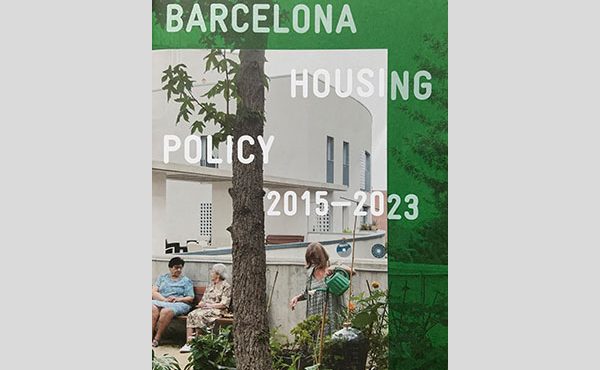
Affordable Housing has been a hot and heavy topic in Vancouver for over a decade. Between 2006 to 2016 the price of detached houses increased by 158.8% while the prices for attached houses have increased by 86.5%. Condominiums have increased by 72.1% and the average rent in CMA has increased by 41.1%. These statistics are grim or great, and reflect the dilemmas of cities: for some they are catalysts of prosperity to others they represent a struggle for inequality. From a supply perspective, Vancouver’s housing market is a seller’s market. But from a demand perspective, homebuyers and renters experience increased challenges to live in a place they can afford to buy or rent.
With this in mind, the Small Housing BC Summit (SHBC) and the annual Housing Central Conference embraced the topic of housing in its multifaceted ways.
“Size Matters” was the motto of the Small Housing BC Summit, tackling the question of affordable homeownership in creative and innovative ways. Over 20 presenters from various backgrounds presented their case studies and discussed the pros and cons of their ideas to roughly 200 attendees.
One of the most compelling and local examples of small living space are the Micro-Loft apartments in Vancouver’s Gastown. As a presenter, Jon Stovell CEO of Reliance Properties explained the advantages of Micro-Lofts as a modern form of living in urban areas. The real estate company converted the 1909-heritage building—known as the Burns Block—into 30 self-contained, fully furnished studio apartments. The six-storey Italianate building is situated at 18 West Hastings close to plenty of amenities, such as coffee shops, Safe-On-Meat and stores. In a survey I conducted for The Changing Image of Affordable Housing, all the participating residents of the Burns Block appreciated the proximity to Vancouver’s downtown the most about living in the building.
Jake Fry, CEO of Smallworks Studios and Laneway Housing Inc. explained that the idea for SHBC “came out of the success of the laneway house program in Vancouver. […] We also recognized the need for public education and research on what opportunities and disadvantages may exist with this type of housing.” Fry emphasized the growing need for laneway homes in Canada and North America for empty nesters as well as young professionals: “I certainly say, without question, that over the last decade, interest on this type of housing has become exponentially attractive to a number of people across North America; mostly individuals that are exiting the workforce and those entering the workforce at a time when home ownership becomes an important strategy to building equity and security.”
To Fry, the “Missing Middle” debate really discusses a missing, and often times, neglected piece within the housing continuum: “We are also looking at ways to create housing affordability because other programs and government resources are being put into that type of housing, in which there is more of an acute need.” For a detailed description about the BC Small Housing Summit you can read Sean Ruthen’s comprehensive article published last week on Spacing Vancouver.
Similar themes continued the day after the BC Small Housing Summit, at the Housing Central Conference organized by the BC Non-Profit Housing Association. The three-day housing conference elevated from being the biggest affordable housing conference in western Canada to being the biggest in all of Canada this year.
The conference kicked off on Sunday with prominent, diverse panelists and keynote speakers. In his introduction speech, plenary guest speaker Shane Pointe encouraged everybody to use their education and knowledge to build a future in which everyone can have safe, livable housing in BC. He also stated his gratitude for Premier John Hogan’s as being the first BC Premier to physically attend the Housing Central Conference.
Minister of Municipal Affairs and Housing of British Columbia Selina Robinson stressed how women —especially single-mothers —are the most vulnerable and at risk of poverty in our society. Lack of affordable child care as well as affordable housing fosters women’s limited choices of well-paid employment. As housing is important, she believes that the National Housing Strategy that will invest $7 Billion in affordable housing over the next 10 years will help vulnerable households to improve their quality of lives.
The Co-operative Housing Federation of BC also held their Annual General Meeting joined by newly-elect mayor Kennedy Stewart who encouraged governments to boost housing co-operatives in Canada.
Attendees were given a choice of over 120 sessions on affordable housing topics, plenary keynotes and networking events about leadership, operations and asset management in housing. The following is a summary of a selection of sessions to highlight some of the key themes during the three days:
Diversity in Housing Options and New Thinking of the Housing Continuum
As Vancouver is struggling with low vacancy rates and high cost of rent, new initiatives are being started that address this issue and offer solutions. Jessica Brooks from the Ministry of Municipal Affairs and Housing explained the planning tools for the new Municipal Land Use that will give local governments increased rental-only zoning power. This will ensure that existing areas of rental housing are preserved and will require that the new housing in residential areas be rental. The overall goal of the legislation is to increase the supply of rental housing in Vancouver and British Columbia.
With the recognition of the urgent need for more rental supply there is also the realization that the conventional ‘Housing Continuum’ model in the linear form might no longer work for everyone. “The need for housing is not a homogenous one, as each community has a different need,” project planner at M’akola Development Services Devan Cronshaw explains, “There may be a contradiction between what the federal government understands as affordable housing vs what the municipal governments understand as affordable housing. This makes it difficult to hit the need for what each community needs.”
The recognition for diversity in housing is important; so is the needs to be consistent with a common definition of what affordable housing actually means. Recognizing these changes in needs, the City of Kelowna in partnership with BC Housing, CMHC and real estate developers did a study with people who have lived experiences of homelessness and other stakeholders to find out what their housing needs are at their current stage in life. They study also looked into if and how those needs will change. As a result of their assessment study – Housing Needs Assessment – the City came up with the Wheelhouse that is a circular version of the housing continuum, reflective of people’s stages in life.

Erin Welk, Civic Social Innovation Lead at Urban Matters explained that people’s lives are not linear. Instead, their circumstances change over different stages in life. The Wheelhouse also recognizes that homeownership is no longer everybody’s goal, as such the need for more rental options increases. The City of Kelowna’s Healthy City Strategy primarily focuses on protecting and promoting rental supply to their clients. “It is really important to include the vulnerable population in your housing needs assessment,” Michelle Kam, Sustainability Coordinator, City of Kelowna stressed.

The surge of new housing non-profits and the increased attendance of municipalities from remote areas such as Oliver, Nelson, Tofino or Whistler showed that affordable housing is not just a problem Vancouver is dealing with. Alex Thumm from the City of Nelson explained: “We don’t have more land to develop, such as greenfield development opportunities, so the demand is to intensify the use of land that has already been developed. This means higher density, such as adding laneway houses to create housing in people’s backyards as well as subdividing existing properties…..We have a serious housing shortage, with vacancy rates being a fraction of Vancouver’s: between 0% and 0.06%. We have a couple forthcoming seniors housing projects, but other than new, market-rate single-family homes, there isn’t enough family-sized housing. Families are turning to basement suites, when available, or moving out of town. That’s one reason why laneway houses make sense for Nelson: ground-level, mid-range housing that offers something in the middle. What’s stopping people from developing often isn’t willpower, but capital: construction costs are higher here than in metropolitan areas. With land values increasing though (single-family homes now typically cost over $500,000), there is ever greater incentive to make better use of the land you already have.”
During the session Innovate This! Projects Transforming Affordable Housing Marla Zucht from Whistler Housing Authority showed innovative and affordable case studies in Whistler. The institution is the only non-profit that offers affordable housing in Whistler, a city that has a high population of residents working in the tourism and hospitality industry—typically lower-paying jobs. Whistler Housing Authority offers rental options that are typically 50% below Whistler’s market value. With its 1020 Legacy Way, the housing non-profit also showcased an example of how to successfully combine energy efficiency with affordable housing and innovative design.
Innovation, Inspiration and Creation: Knowledge expertise of BC’s real estate world and importance of Partnerships
Marla Zucht was accompanied by Lance Jakubec (Affordable Housing Specialist, CMHC), Christine Culham (Senior Manager of Regional Housing, Capital Regional District) along with Vancity Credit Union’s Lillian Chaw all of whom stressed the importance of partnerships for creating successful housing models. This is especially the case with the uncertainty that can come with a potential new government and termination of the National Housing Strategy. New and innovative models that are not dependant on government funding are crucial for a sustainable realization of housing projects.
Coupled with the importance of partnerships is the need for the ever-expanding knowledge skill set of housing non-profits’ staff. Kaye Melliship, Executive Director at Greater Victoria Housing Society shared her experience of hiring a real estate developer on a consultancy basis. She thinks a holistic skillset of real estate knowledge is crucial for the success of a housing non-profit. “People with experience in the real estate business have a lot of opportunity. There is demand for their expertise and competition over them.” With this in mind, it was stated that non-profits should look into training their in-house staff, as they are the ones closer to the community and can build better relationships with them, accordingly. Brightside Community Homes Foundation’s Executive Director Jan Robinson agreed with that thought, “We think in the long run it might be more cost effective to have our own real estate department. We want to create our own arm of real estate developers.”
Another innovative way to get real estate expertise for housing non-profits, it was suggested, is through the Urban Land Institute’s Technical Assistance Panels, or TAP. As Bryce Tupper, Chair of the Technical Assistance Panel at the Urban Land Institute explained, what the TAP offers to non-profits, “is very much like a feasibility study with options assessment, market elements and locational realities as well as an assessment of what the best way forward is.” He also stressed that TAP is not just “a financial analysis. We are trying to get in the heads of the societies and find out ‘How do we further what you want to do?’ If you want to increase your units that is one thing. There is a difference between living in a fourplex and ones own apartment.” Tupper thinks some of the benefits of requesting TAP services vs. hiring a real estate consultant lies in the cost. For TAP the cost is around $12,000, while a private consultant can be as expensive as $40,000.
Beyond the above, the business model for non-profit organizations was discussed. How can non-profits become more independent from government funding? What type of partnerships will contribute well towards boosting revenue? Karen Hemmingson from BC Housing encouraged non-profits to shift their mindset to align more with those of commercial businesses. As such, the expertise and skills of staff, board, CEO and external contractors need to address these changes accordingly. Some key themes of a changing mindset for non-profits would be taking strategic action, renewing partnerships and diversifying their portfolios.
Building Green and the Economic Factor of Affordable Housing Buildings
Affordable housing providers increasingly have to look for innovative ways to save costs in heat, hydro and other consumption. As such, energy efficiency in buildings and affordable housing go hand in hand. Studies show that building green can be cost effective and sustainable in the long run.
As a charter city, the City of Vancouver has its own bylaws including a Green Buildings Policy for Rezoning. On a provincial level, the BC Energy Step Code will standardize green building regulations as of December 8th 2018. It is a performance-based rather than prescription-based approach that encompasses 5 steps that depend on each municipality’s climate zone. At the session Leading Edge Energy & Construction Standards, Bill MacKinnon, BC Housing’s Energy Manager, explained how the envelope-first approach towards improving buildings’ energy efficiency standards was inspired by the Passive House that originated in Germany.
MacKinnon recommended to “start early in the design. That will be helpful to move forward in the early stages.” Concerns from the audience about the BC Energy Step Code were plenty. One non-profit member was concerned that the Code does not take people’s lifestyles into consideration. It requires a lot of education to teach tenants how to use a Passive House building and resources in the non-profit sector are already skimpy. “The learning curve is too steep for our tenants,” another audience member concurred.
MacKinnon emphasized that tenant engagement and education are important to make the usage of the building work smoothly. He also mentioned Terra Housing’s Budzey Building on 220 Princess Ave—an affordable housing project in Vancouver that is LEED certified and encompasses passive design.
Overall, the enhanced quality of the sessions, increased volume of attendees and appearance of government officials of all levels of government in Canada are proof of the thoughtfulness and quality that the BC Non-Profit Housing Association‘s staff put into this year’s Housing Central Conference. Furthermore, this year’s conference also reflects the heightened need for quality education, partnership and eventually action for building housing options as diverse and multifaceted as ever in the history of British Columbia.
***
Ulduz Maschaykh is an art/urban historian with an interest in architecture, design and the impact of cities on people’s lives. Through her international studies in Bonn (Germany), Vancouver (Canada) and Auckland (New Zealand) she has gained a diverse and intercultural understanding of cultures and cities. She is the author of the book, “The Changing Image of Affordable Housing – Design, Gentrification and Community in Canada and Europe”




